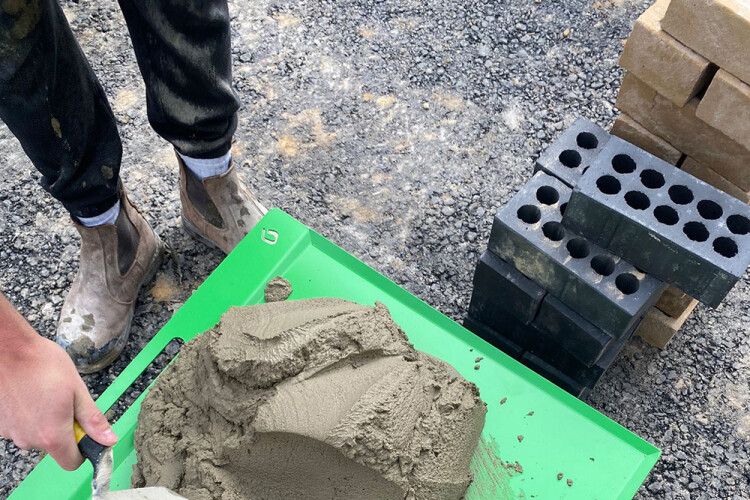Specialist contractor Galostar Brickwork has become the first major brickwork subcontractor in the UK to banish wooden spot boards from all of its sites.
Why? Because the sheets of chipboard or plywood commonly used by bricklayers to mix their mortar on create a huge environmental headache for contractors.
Every year an estimated 85,000 bricklayers across the UK send thousands of tonnes of contaminated waste to landfill, much of it being mortar-impregnated chipboard.
So in a bid to make itself more environmentally sustainable, Galostar has abandoned this wasteful practice and equipped its bricklayers with new patent-protected, 100% recyclable aluminium spot boards made by Grayson, a national supplier of brickwork consumables and sundries.
The reusable aluminium boards sit on their own folding metal stands instead of resting on stacks of bricks, blocks or milk crates in the normal way.
The idea for the new spot boards came to Grayson’s managing director Tony Higson after observing normal practice on site.
“I’ve spent the past 20 years visiting building sites and hardly noticed all the squares of chipboard sitting on half-a-dozen bricks and covered in mortar. Then one day I walked past a skip full of this stuff and I thought there must be a better way,” he says.
Higson saw reusable plastic spot boards listed in a well-known tool-merchant’s catalogue. But his initial enthusiasm quickly subsided when realised that these did not solve the problem as he saw it:
“Thinking about it, I realised that they wouldn’t last very long and in the end they’d also end up in landfill. “But metal is always recyclable – it goes on forever,” he says.
Higson, in addition to his role at Grayson, is also a director ACS Stainless, a manufacturer of stainless steel building products. But stainless steel was not the answer – too heavy, too expensive – he decided. So he spoke to his brother-in-law who runs an aluminium glazing business and together they knocked-up a couple of prototype spot boards and started hawking them around some of the leading London brickwork contractors.
“They were all interested, but they started getting a bit fussy, saying ‘can you put a lip around the edge?’ ‘What about a carry-handle?’ ‘It needs a nail-hole to hang it on’,” says Higson.
They might have been fussy but this was valuable feedback and Higson made the improvements. However the amount of work required to perfect such a seemingly simple product took Higson by surprise.
“We applied for a patent because of the sheer amount of work and IP [intellectual property] that went into it,” he says. “Getting it right was a real ball-ache.”
The finished product is a board and stand with a tough scratch-resistant, wipe-clean powder-coated surface. The response from customers has been “amazing”, says Higson.
Contractors could see the benefits to productivity as well as to the environment. The traditional wooden board on an improvised base of bricks is clumsy and bothersome to move as the work progresses. “You usually have to pay a labourer to clear up after the brickies and you end up with random bricks lying around to trip over,” says Higson.

With the Grayson spot board, the brickies themselves simply lift the board, fold the stand and move it along with all their other tools. It’s much quicker and it’s safer, says Higson.
And he is quick to counter any suggestion that the old chipboard-and-bricks solution makes efficient use of offcuts. Most of the time, sheets of chipboard or ply are bought in specially and have to be cut into boards by a chippie. That’s inefficient and wasteful, says Higson.
These are all compelling arguments, but are they enough to persuade the average brickie to abandon his or her old ways and buy a shiny new aluminium spot board?
Most unlikely, admits Higson.
“I’m never going to get rich with this,” he says. “It’ll do the Grayson brand some good, but I’ve spent more developing this than I’m ever likely to make out of it.
“We’re giving them away. So when a customer places a big order for cavity trays or DPCs we’ll give them a spot board,” explains Higson.
Presented with a freebie, the customer is bound to try it out, and only then are they likely to appreciate its benefits. No amount of cold selling will persuade them, admits Higson, especially as the board itself costs £50 plus VAT and the stand another £30.
Galostar wasn’t the first brickwork contractor to start using the new spot board, but it was the first to adopt it on every site – and, yes, it was the free gift that tipped the balance.
“Galostar was working on a big project in London and they went to the contractor, Bam, and asked if they would contribute to the use of our spot boards on the contract. Bam took one look at it and said ‘Yes, and we’ll pay for it’,” says Higson.
Galostar has since equipped all of its bricklayers with the new spot board. The company’s contracts manager Joel Riley, says: “While this is a bold, and costly, move for Galostar Brickwork, it is one that as a top-tier subcontractor, we are proud to be leading the industry on.”
Other leading brickwork contractors, including London firms Lee Marley and Swift Brickwork and Manchester-based Cara have since embraced the new product. “Lee Marley’s the biggest brickwork contractor in the country and he’s using them,” says Higson.
“Lee wanted to be the first to adopt them but Joel beat him to it – he saw that it would put a massive green tick in the environmental box
for him.”
Got a story? Email news@theconstructionindex.co.uk



